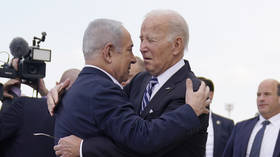Tarik Cyril Amar is a historian and expert on international politics. He has a BA in Modern History from Oxford University, an MSc in International History from the LSE, and a PhD in History from Princeton University. He has held scholarships at the Holocaust Memorial Museum and the Harvard Ukrainian Research Institute and directed the Center for Urban History in Lviv, Ukraine. Originally from Germany, he has lived in the UK, Ukraine, Poland, the USA, and Turkey.
His book 'The Paradox of Ukrainian Lviv: A Borderland City between Stalinists, Nazis, and Nationalists'
was published by Cornell University Press in 2015. A study of the
political and cultural history of Cold War television spy stories is
about to appear, and he is currently working on a new book on the global
response to the war in Ukraine. He has given interviews on various
programs, including several on Rania Khlalek Dispatches, Breakthrough
News.
His website is https://www.tarikcyrilamar.com/; he is on substack under https://tarikcyrilamar.substack.com, and tweets under @TarikCyrilAmar.
 ̄ ̄ ̄ ̄ ̄ ̄
A halfway even-handed international community would have to step in and protect the victims of the disproportionate Israeli retaliation, which multiple international voices have called a genocide and an ethnic cleansing. Failure to do so reveals profound bias and dysfunction. That much is obvious.

Instead, the Biden administration deterred anyone who could have been tempted to interfere with Israel. Washington has also supplied arms and ammunition, intelligence, and special forces assistance, and provided diplomatic cover. This brings us to the other fact that we need to wake up to: the single greatest danger to a modest minimum of fair and reliable global order, and thus stability, is the US. This is not a polemical point but the conclusion of a dispassionate analysis of Washington’s persistent capacities and empirical record since, roughly, the end of the Soviet Union, which marked the beginning of America’s “unipolar moment.”
All this economic oomph translates into enormous military budgets. Whether in nominal terms or adjusted for purchasing power, America outdistances other nations, with 40% of all money spent on the military worldwide in 2022.
Indicators could be multiplied, categories refined. Yet the overall picture would not change. At this point in time, the US is still a power giant, and, on top of that, it remains at the top of the most powerful complex of alliances in the world. The sheer size of American power alone tells us little about how it is used. But what is too often overlooked is that without it, America – whatever its policies – simply could not be so influential.
There is clear, again quantitative, evidence that Washington’s influence is highly disruptive. According to the conservative journal The National Interest, between 1992 and 2017, the US has been involved in 188 “military interventions.” This list is incomplete; it does not include, for instance, the Gulf War of 1990 or the pivotal role Washington played in provoking and then waging a proxy war against Russia in Ukraine. Moreover, as you would expect, given the source, these are conservative figures. By 2022, Ben Norton, a well-informed critic of US politics on the left found 251 military interventions after 1991.
The US has not only shown a high propensity to pursue its perceived interests abroad by military force – instead of diplomacy or even “merely” economic warfare, i.e. sanctions. What is at least equally concerning is that this preference for direct violence as a tool of policy is accelerating. The National Interest finds that – again between 1992 and 2017 – America was engaged in four times as many military interventions as between 1948 and 1991 (“only” 46 times). Likewise, the Military Intervention Project at Tufts University’s Center for Strategic Studies has found that the US “has undertaken over 500 international military interventions since 1776, with nearly 60% undertaken between 1950 and 2017” and “over one-third” of these missions occurring after 1999. US bellicosity has grown over time (though not evenly) and, recently, after the end of the Cold War and the former Soviet Union, that growth has sped up.
These wars, moreover, have been extremely destructive. According to exhaustive research conducted by the Costs of War project at Brown University, the so-called “Global War on Terror” after 2001 alone produced between 905,000 and 940,000 “direct war deaths.” The same research project notes that the “destruction of economies, public services, infrastructure, and the environment” by these wars has caused an additional “3.6-3.8 million indirect deaths in post-9/11 war zones.” The fact that most of these deaths were “indirect” shows that, even without engaging in violence directly, Washington has an extraordinary knack of spreading lethal disruption.

